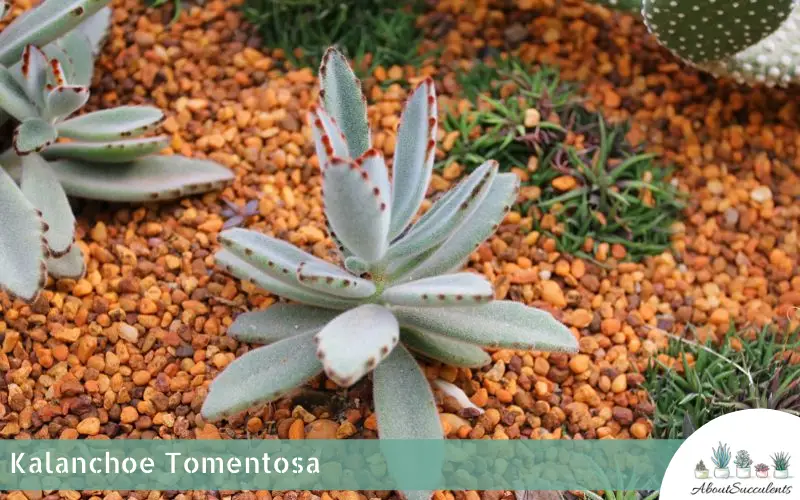
Kalanchoe tomentosa is an adorable succulent that also goes by the names of Pussy Ears and Panda Plant because of the plant having furry leaves. Translated to English, “tomentosa” means “covered with fine hairs”.
Pussy Ears has a robust stem that is quite hirsute and produces an assortment of leaves and branches. Pussy Ears can grow from 1-foot to 1.5-feet in height or 35cm to 45cm.
The leaves of the Kalanchoe tomentosa succulent have bluish-green hairs near the center of the plant. The hairs at the tips have a rich chocolate color which lends to Pussy Ears’ interesting appearance.
Contributing to the cat-like ears of the leaves is its oval shape. Pussy Ears’ leaves are thick and are helpful in helping the plant store water.
Kalanchoe tomentosa does not produce as many flowers as other types of succulents but it may bloom during the summer. The flowers appear in a variety of colors – yellow green with dark brown tips on its petals.
Kalanchoe tomentosa originates from the Crassulaceae family and is native to Madagascar.
General Information:
Also known as: Pussy Ears, Panda Plant, Chocolate Soldier Plant
Plant Family: Crassulaceae
Origin: Madagascar.
Height: 1-foot to 1.5-feet in height or 35cm to 45cm
Exposure: Direct morning sun up to 6 hours outdoors or indoors.
Water Needs: Light watering schedule during the summer months; very little to no watering in the winter or cold season.
Soil Type: Cacti soil or commercially available potting soil with good draining properties.
Soil pH: Strongly Acidic (5.5 to 7.5 pH)
Tolerance: Drought and dry air
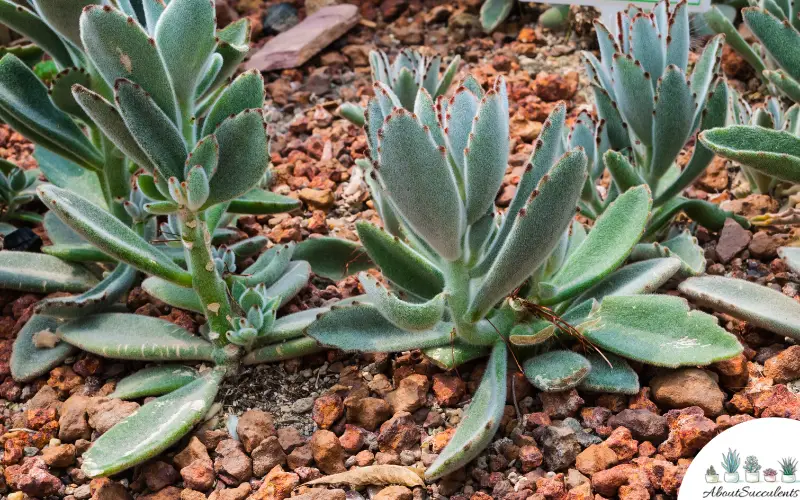
How To Grow Kalanchoe Tomentosa
Kalanchoe tomentosa is the perfect succulent for first-time garden hobbyists because it is very easy to grow. When Pussy Ears gains full maturity, it would look great in a hanging basket.
The Kalanchoe tomentosa plant is also used as a ground cover when planted outdoors or as an accent plant in a succulent garden.
If your region experiences frequent rainy weather, it would be advisable to place Pussy Earns inside a well-draining pot and grow it indoors.
1. Sunlight
Kalanchoe tomentosa is typical of most succulents in that it enjoys basking under the bright light of the morning sun. If grown outside, plant Pussy Ears in a location that receives 6 hours of the morning sun.
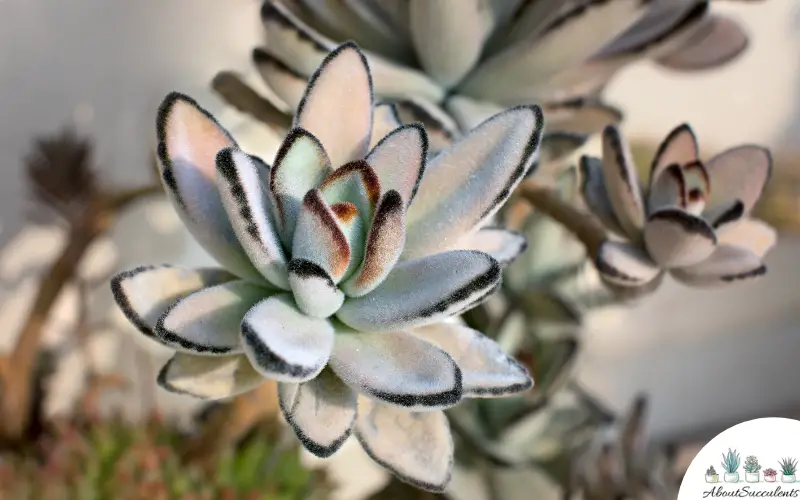
If you prefer to grow Panda Plant indoors, make sure it is located in a place that receives direct light from the sun for at least 6 hours.
Assuming this is not possible you can buy a Grow Light. Place the succulent under the Grow Light to get its daily dose of the sun’s rays.
If you decide to transfer Kalanchoe tomentosa back to the outdoors, do it gradually. Place Panda Plant under the partial sun for a while before moving it to a location that gets direct sunlight.
2. Watering
Kalanchoe tomentosa is a durable succulent and is highly resistant to drought. Pussy Ears can go on extended periods without water and still survive. The succulent can also tolerate dry air.
The best way to water Pussy Ears is to check the moist level of its soil. If it is dry to the touch, give it water. If water starts to drip on the tray below the soil, stop watering the plant.
Do not water the thick leaves of Pussy Ears because this will easily lead to overwatering.
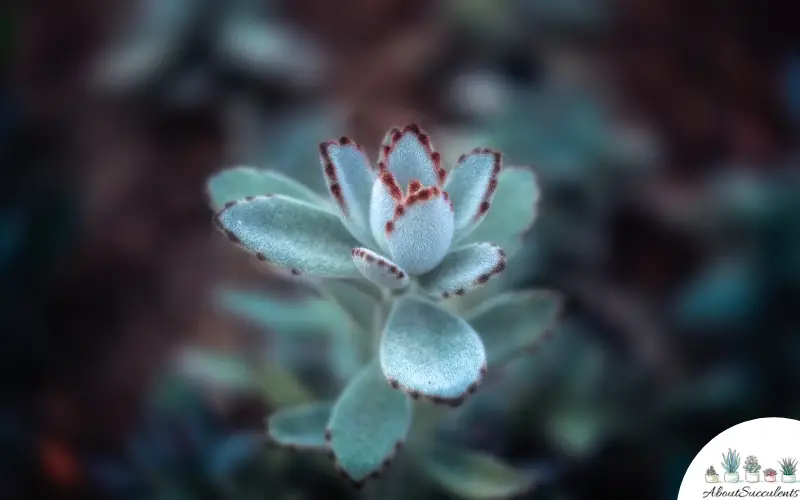
3. Pot and Soil
For Kalanchoe tomentosa, use a pot that has fast drainage. If you are thinking of planting several Pussy Ears, keep the seeds at least 36-inches (91cm) apart.
At this distance, the plants can grow to full maturity without the risk of crowding at the roots.
The best soil to use would be cacti or a commercial mix for succulent. It is important to be sure that the soil is well-draining. You can add grit to improve its draining capability. Add fertilizer to the soil every month during the spring and summer seasons.
How To Propagate Kalanchoe Tomentosa
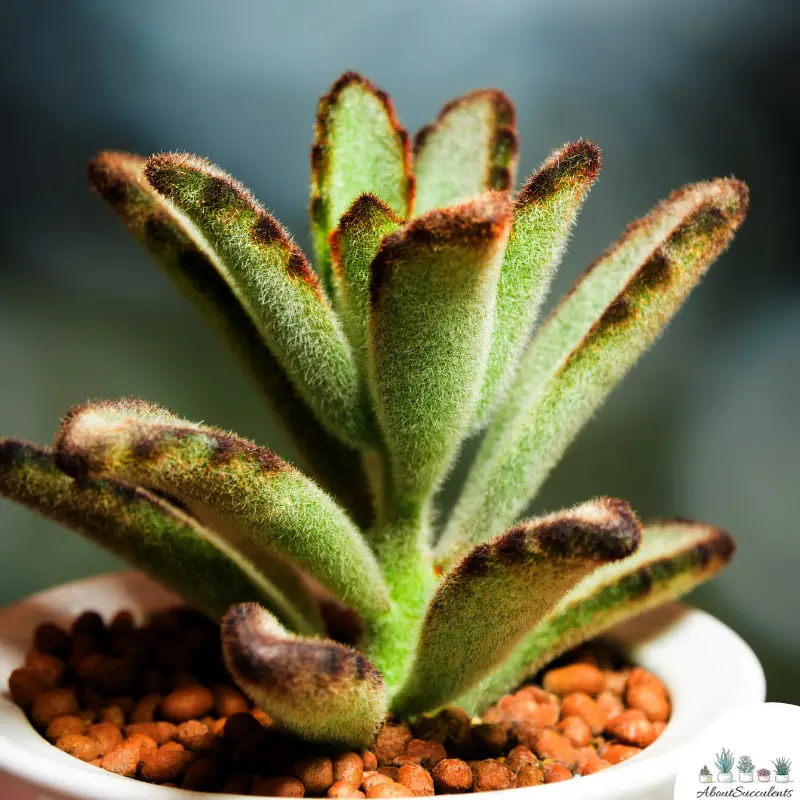
Kalanchoe tomentosa can easily be propagated from leaves. Propagation is best done in the spring or early part of the summer season.
Step 1 – Cut the leaf by using a sharpened and sanitized pair of garden shears or knife.
Step 2 – Place the leaf in a dry and shaded location for around 1 week to allow it to harden and develop calluses.
Step 3 – Plant the leaf cuttings in a pot filled with well-draining soil.
Step 4 – Transfer the pot to an area that receives direct sunlight.
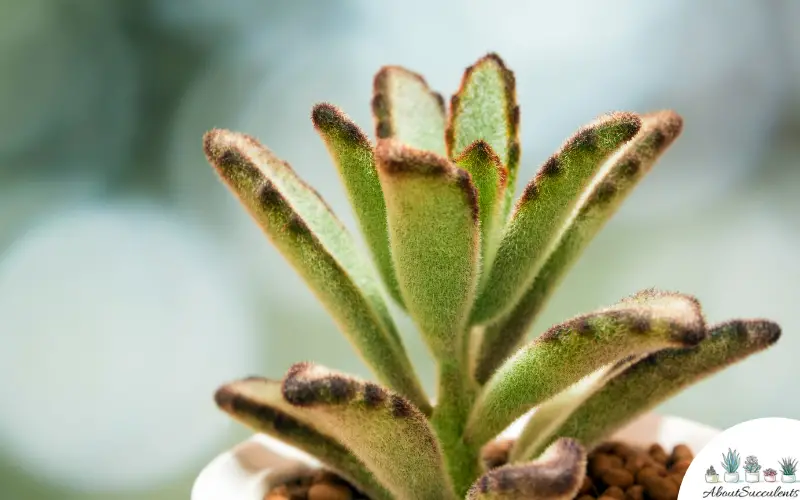
You can expect the leaves to grow roots within 4 weeks. From there, look out for the leaves to sprout from the stems. At this point, you can transfer the pot outdoors.
Frequently Asked Questions
Is Kalanchoe Tomentosa Toxic for Cats and Dogs?
Yes, Kalanchoe tomentosa is toxic for cats and dogs. The succulent plant is identified on the website of the American Society for the Prevention of Cruelty to Animals (ASPCA) as a succulent that is poisonous to animals.
Once ingested by your pet, it could lead to gastrointestinal distress, excessive salivation, and changes in behavior. If you notice any one of these symptoms, bring your pet to the veterinarian right away.
Why is my Kalanchoe Tomentosa Succulent Dying?
There are 2 possible causes of death for Kalanchoe tomentosa: Overwatering and infestation.
Overwatering
A succulent can thrive even if you don’t give it water for long periods. In the case of Pussy Ears, its thick leaves allow it to store water as a means of survival.
Overwatering is the leading cause of death for all succulents and the Kalanchoe tomentosa is not an exception.
When a succulent plant receives too much water or is submerged in water for a long time, its roots will begin to rot. You will notice a change in color in the plant. Its stem or leaves may show a brownish color that is indicative of rotting.
Once you see evidence of rotting, cut off the part of the section of the plant right away as it may contaminate the rest of the succulent.
Pests and Diseases
The thick leaves of the Panda Plant attract mealybugs and other pests. Mealybugs leave a white, cotton-like substance on the leaves of the plant. It may be hard to see because of the furry appearance of Panda Plant’s leaves.
You have to frequently check the leaves to be sure there is no sign of mealybug infestation which can lead to rotting. You can keep insects off Panda Plant by occasionally spraying with a mild commercial pesticide that is formulated for succulents.
Does Kalanchoe Tomentosa Produce Flowers?
Yes, Kalanchoe tomentosa produces flowers during the summer and in the spring. The flowers have a tubular shape and measure 11-inches or 30cm in length.
This type of succulent rarely produces flowers especially when grown indoors. If you want Pussy Ears to bloom, it would be best to plant it outdoors.
Last Updated on June 10, 2022 by Sofia Lara